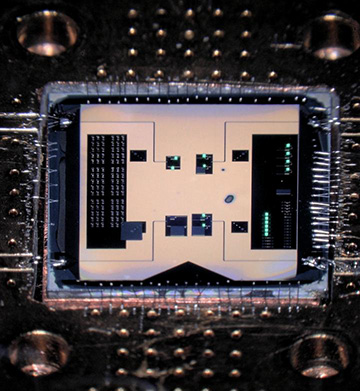
A superconducting quantum circuit, embedded in a 1×1-cm chip, allowed a team led by TU Delft researchers to observe the quantization of a radio-frequency electromagnetic field in a microresonator, and to stabilize the system to form one- and two-photon states within the resonator. [Image: TU Delft]
Recent years have seen amazing progress in detecting manipulating single photons, in the infrared, visible and even microwave bands. But detecting single photons in the radio-frequency (RF) band, at megahertz frequencies, is a tougher nut to crack, because—even in cryogenically cooled systems—background thermal fluctuations easily overwhelm the delicate, long-wavelength quantum signal. That’s a pity, since single-photon control at RF frequencies could allow significant sensitivity jumps for applications ranging from magnetic-resonance imaging (MRI) to radio astronomy.
Now, researchers at the Delft University of Technology (TU Delft), Netherlands, and Northwestern University, USA, have been able to directly observe quantization of an RF field in a microresonator, and to coax the field into one- and two-photon states in the resonator by carefully cooling things down (Science, doi: 10.1126/science.aaw3101). The team sees applications for the technique not only in sensing and imaging, but in pushing the envelope for studies of quantum thermodynamics and even quantum gravity.
Leveraging cQED
The research team, led by Gary Steele at TU Delft, accomplished this RF feat by leveraging the tools of circuit quantum electrodynamics (cQED) already used to cool and manipulate microwave electromagnetic fields. To build the right superconducting circuit, the team began with a high-resistivity silicon substrate. Then, the researchers used shadow evaporation to fashion an Al/AlOx/Al Josephson junction tied to a capacitor, and sputter-deposited and patterned aluminum to create a 23-turn spiral inductor, around 80 microns across and consisting of wires 500 nm wide.

Electron micrograph of the quantum circuit. The spiral inductor lies in the upper left quadarant; the Josephson junction is in the bottom center. The width of the image corresponds to a third of a millimeter. [Image: TU Delft]
The detailed configuration of the circuit is such that it has two resonance modes: a low-frequency mode, in which the spiral inductor’s capacitance is negligible and the resonance lies at 173 MHz, in the RF band; and a high-frequency mode, in which the inductor capacitance becomes important and the resonance is on the order of 5.9 GHz. The two resonance modes effectively share the Josephson junction. And, because the junction’s inductance varies with current fluctuations, “the resonance frequency of the high-frequency mode shifts as a function of the number of excitations in the low-frequency mode,” according to the paper.
Four-wave mixing
Using this setup and these relationships, the team was able to create a superconducting transmon quantum bit (qubit) in the high-frequency, gigahertz mode. Then, by coherently pumping the system at a specific frequency, the researchers enabled a four-wave mixing process, by which each pump photon annihilates a photon in the low-frequency, megahertz resonator mode and creates two photons in the high-frequency transmon mode.
By driving the pump tone so that the four-wave mixing process proceeded faster than the thermalization rate of the microresonator, the team found it could cool the resonator to its ground state. And, using additional pump-tone manipulation, the researchers were able to stabilize the system into one- and two-photon Fock states. (A Fock state is a state with a well-defined number of quantum particles.) Finally, switching off the pump-tone control for specific intervals allowed the team to watch the rethermalization of the resonator, and to map out its progress at nanosecond resolution.
From MRI to radio astronomy to gravity
The researchers note in the paper that the cQED architecture they’ve developed “enables the readout and manipulation of a radio-frequency resonator at the quantum level.” That’s a capability, they suggest, that could open up the heretofore elusive prospect of sensing RF signals with quantum resolution, for applications in MRI, radio astronomy and more.
The team also thinks that opening a window to RF quanta could shed light on one of the bigger quandaries of physics: the relationship between quantum mechanics and gravity.
“Using our quantum radio, we want to try to listen to and control the quantum vibrations of heavy objects, and explore experimentally what happens when you mix quantum mechanics and gravity,” the paper’s lead author, Mario Gely of TU Delft, said in a press release accompanying the work. “Such experiments are hard, but if successful we would be able to test if we can make a quantum superposition of space-time itself, a new concept that would test our understanding of both quantum mechanics and general relativity.”
